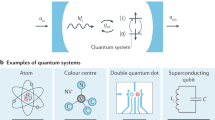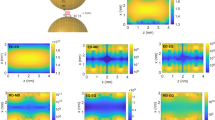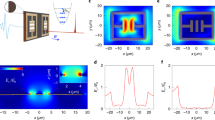Abstract
The recent development of techniques to produce optical semiconductor cavities of very high quality has prepared the stage for observing cavity quantum-electrodynamic effects in solid-state materials. Among the most promising systems for these studies are semiconductor quantum dots inside photonic crystal, micropillar or microdisk resonators. We review the progress so far in obtaining true quantum-optical strong-coupling effects in semiconductors. We discuss the recent results on vacuum Rabi splitting with a single quantum dot, emphasizing the differences from quantum-well systems. Finally, we propose nonlinear tests for the true quantum limit and speculate about applications in quantum information devices.
This is a preview of subscription content, access via your institution
Access options
Subscribe to this journal
Receive 12 print issues and online access
$209.00 per year
only $17.42 per issue
Buy this article
- Purchase on Springer Link
- Instant access to full article PDF
Prices may be subject to local taxes which are calculated during checkout





Similar content being viewed by others
References
Berman, P. R. (ed.) Cavity Quantum Electrodynamics (Academic, Boston, 1994).
Haroche, S. & Kleppner, D. Cavity quantum electrodynamics. Phys. Today 24–30 (January, 1989).
McKeever, J., Boca, A., D. Boozer, A., Buck, J. R. & Kimble, H. J. Experimental realization of a one-atom laser in the regime of strong coupling. Nature 425, 268–271 (2003).
Kimble, H. J. Strong interactions of single atoms and photons in cavity QED. Phys. Scripta 76, 127–137 (1998).
Hood, C. J., Chapman, M. S., Lynn, T. W. & Kimble, H. J. Real-time cavity QED with single atoms. Phys. Rev. Lett. 80, 4157–4160 (1998).
Ye, J., Vernooy, D. W. & Kimble, H. J. Trapping of single atoms in cavity QED. Phys. Rev. Lett. 83, 4987–4990 (1999).
Nogues, G. et al. Seeing a single photon without destroying it. Nature 400, 239–242 (1999).
Haroche, S. Entanglement, decoherence and the quantum/classical boundary. Phys. Today 36–42 (July, 1998).
Bertet, P. et al. A complementarity experiment with an interferometer at the quantum-classical boundary. Nature 411, 166–170 (2001).
Raimond, J. M., Brune, M. & Haroche, S. Manipulating quantum entanglement with atoms and photons in a cavity. Rev. Mod. Phys. 73, 565–582 (2001).
Birnbaum, K. M. et al. Photon blockade in an optical cavity with one trapped atom. Nature 436, 87–90 (2005).
Marzin, J.-Y., Gérard, J.-M., Izraël, A., Barrier, D. & Bastard, G. Photoliminescence of single InAs quantum dots obtained by self-organized growth on GaAs. Phys. Rev. Lett. 73, 716–719 (1994).
Gammon, D., Snow, E. S., Shanabrook, B. V., Katzer, D. S. & Park, D. Homogeneous linewidths in the optical spectrum of a single gallium arsenide quantum dot. Science 273, 87–90 (1996).
Michler, P. et al. Quantum correlation among photons from a single quantum dot at room temperature. Nature 406, 968–970 (2000).
Purcell, E. M. Spontaneous emission probabilities at radio frequencies. Phys. Rev. 69, 681–681 (1946).
Gérard, J. M. et al. Enhanced spontaneous emission by quantum boxes in a monolithic optical microcavity. Phys. Rev. Lett. 81, 1110–1113 (1998).
Bayer, M. et al. Inhibition and enhancement of the spontaneous emission of quantum dots in structured microresonators. Phys. Rev. Lett. 86, 3168–3171 (2001).
Thompson, R. J., Rempe, G. & Kimble, H. J. Observation of normal-mode splitting for an atom in an optical cavity. Phys. Rev. Lett. 68, 1132–1135 (1992).
Bernardot, F., Nussenzvieg, P., Brune, M., Raimond, J. M. & Haroche, S. Vacuum Rabi splitting on a microscopic atomic sample in a microwave cavity. Europhys. Lett. 17, 33–38 (1992).
Jaynes, E. T. & Cummings, F. W. Comparison of quantum and semiclassical radiation theories with application to beam maser. Proc. IEEE 51, 89–109 (1963).
Carmichael, H. J., Brecha, R. J., Raizen, M. G., Kimble, J. & Rice, P. R. Subnatural linewidth averaging for coupled atomic and cavity-mode oscillators. Phys. Rev. A 40, 5516–5519 (1989).
Andreani, L. C., Panzarini, G. & Gérard, J. M. Strong-coupling regime for quantum boxes in pillar microcavities: Theory. Phys. Rev. B 60, 13276–13279 (1999).
Goldstein, E. & Meystre, P. in Spontaneous Emission and Laser Oscillations in Microcavities (eds Yokoyama, H. & Ujihara, K.) 1–46 (CRC, New York, 1995).
Gibbs, H. M. in Optics of Semiconductors and Their Nanostructures (eds Kalt, H. & Hetterich, M.) 189–208 (Springer, Berlin, 2004).
Prineas, J. P. et al. Exciton-polariton eigenmodes in light-coupled In0.04Ga0.96As/GaAs semiconductor multiple quantum well periodic structures. Phys. Rev. B 61, 13863–13872 (1994).
Boca, A. et al. Observation of the vacuum Rabi spectrum for one trapped atom. Phys. Rev. Lett. 93, 233603 (2004).
Reithmaier, J. P. et al. Strong coupling in a single quantum dot-semiconductor microcavity system. Nature 432, 197–200 (2004).
Yoshie, T. et al. Vacuum Rabi splitting with a single quantum dot in a photonic crystal nanocavity. Nature 432, 200–203 (2004).
Peter, E. et al. Exciton photon strong-coupling regime for a single quantum dot in a microcavity. Phys. Rev. Lett. 95, 067401 (2005).
Zhu, Y. et al. Vacuum Rabi splitting as a feature of linear-dispersion theory: Analysis and experimental observations. Phys. Rev. Lett. 64, 2499–2502 (1990).
Khitrova, G. in Quantum Optoelectronics, Postconference Edition of Technical Digest 77–78 (Optical Society of America, Washington, 1999).
Khitrova, G., Gibbs, H. M., Jahnke, F., Kira, M. & Koch, S. W. Nonlinear optics of normal-mode-coupling semiconductor microcavities. Rev. Mod. Phys. 71, 1591–1639 (1999).
Ell, C. et al. Toward quantum entanglement in a quantum-dot nanocavity. IEEE LEOS Newslett. 13, 8–9 (1999).
Andreani, L. C., Panzarini, G. & Gérard, J. M. Vacuum-field Rabi splitting for quantum boxes in pillar microcavities. Phys. Stat. Solidi A 178, 145–148 (2000).
Vuc˘ković, J. & Yamamoto, Y. Photonic crystal microcavities for cavity quantum electrodynamics with a single quantum dot. Appl. Phys. Lett. 82, 2374–2376 (2003).
Vahala, K. J. Optical microcavities. Nature 424, 839–846 (2003).
Lefevre-Seguin, V. & Haroche, S. Towards cavity-QED experiments with silica microspheres. Mater. Sci. Eng. B 48, 53–58 (1997).
Fan, X., Palinginis, P., Lacey, S., Wang, H. & Lonergan, M. Coupling semiconductor nanocrystals to a fused-silica microsphere: a quantum-dot microcavity with extremely high Q factors. Opt. Lett. 25, 1600–1602 (2000).
Raymer, M. G. et al. in Frontiers in Optics/Laser Science XIX WGG5 (Optical Society of America, Washington, 2003).
Cui, G. et al. A hemispherical, high-solid-angle optical micro-cavity for cavity-QED studies. Preprint at <http://arxiv.org/abs/quant-ph/0601046> (2006).
Stanley, R. P., Houdré, R., Oesterle, U., Gailhanou, M. & Ilegems, M. Ultrahigh finesse microcavity with distributed Bragg reflectors. Appl. Phys. Lett. 65, 1883–1885 (1994).
Gérard, J. M. et al. Quantum boxes as active probes for photonic microstructures: The pillar microcavity case. Appl. Phys. Lett. 69, 449–451 (1996).
McCall, S. L., Levi, A. F. J., Slusher, R. E., Pearton, S. J. & Logan, R. A. Whispering-gallery mode microdisk lasers. Appl. Phys. Lett. 60, 289–291 (1992).
Srinivasan, K. et al. Optical loss and lasing characteristics of high-quality-factor AlGaAs microdisk resonators with embedded quantum dots. Appl. Phys. Lett. 86, 151106 (2005).
Painter, O. et al. Two-dimensional photonic band-gap defect mode laser. Science 284, 1819–1821 (1999).
Yoshie, T. O., Shchekin, B., Chen, H., Deppe, D. G. & Scherer, A. Quantum dot photonic crystal lasers. Electron. Lett. 38, 967–968 (2002).
Akahane, Y., Asano, T., Song, B.-S. & Noda, S. High-Q photonic nanocavity in a two-dimensional photonic crystal. Nature 425, 944–947 (2003).
Song, B.-S., Noda, S., Asano, T. & Akahane, Y. Ultra-high-Q photonic double-heterostructure nanocavity. Nature Mater. 4, 207–210 (2005);ibid in First Conf. Advances in Optical Materials abstract IS17 (Elsevier, Oxford, 2005).
Hendrickson, J. et al. Quantum dot photonic-crystal-slab nanocavities: quality factors and lasing. Phys. Rev. B 72, 193303 (2005).
Ekimov, A. I. & Onushchenko, A. A. Quantum size effect in three dimensional microscopic semiconductor crystals. JETP Lett. 34, 345 (1981).
Efros, Al. L. & Efros, A. L. Interband absorption of light in a semiconductor sphere. Sov. Phys. Semicond. 16, 772 (1982).
Zrenner, A. et al. Quantum dots formed by interface fluctuations in AlAs/GaAs coupled quantum well structures. Phys. Rev. Lett. 72, 3382–3385 (1994).
Brunner, K., Abstreiter, G., Böhm, G., Tränkle, G. & Weimann, G. Sharp-line photoluminescence and two-photon absorption of zero-dimensional biexcitons in a GaAs/AlGaAs structure. Phys. Rev. Lett. 73, 1138–1141 (1994).
Gammon, D., Snow, E. S., Shanabrook, B. V., Katzer, D. S. & Park, D. Fine structure splitting in the optical spectra of single GaAs quantum dots. Phys. Rev. Lett. 76, 3005–3008 (1996).
von Freymann, G. et al. Level repulsion in nano-photoluminescence spectra from single GaAs quantum wells? Phys. Rev. B 65, 205327 (2002).
Leonard, D. et al. Direct formation of quantum-sized dots from uniform coherent islands of InGaAs on GaAs surfaces. Appl. Phys. Lett. 63, 3203–3204 (1993).
Moison, J. M. et al. Self-organized growth of regular nanometer-scale InAs dots on GaAs. Appl. Phys. Lett. 64, 196–198 (1994).
Petroff, P. M., Lorke, A. & Imamoglu, A. Epitaxially self-assembled quantum dots. Phys. Today 46–52 (May, 2001).
Bányai, L. & Koch, S. W. Semiconductor Quantum Dots (World Scientific, Singapore, 1993).
Zrenner, A. A close look on single quantum dots. J. Chem. Phys. 112, 7790–7798 (2000).
Kammerer, C. et al. Line narrowing in single semiconductor quantum dots: Toward the control of environment effects. Phys. Rev. B 66, 041306 (2002).
Birkedal, D., Leosson, K. & Hvam, J. M. Long coherence times in self-assembled semiconductor quantum dots. Superlattice Microstruct. (special issue) 31, 97–105 (2002).
Bayer, M. & Forchel, A. Temperature dependence of the exciton homogeneous linewidth in In0.60Ga0.40As/GaAs self-assembled quantum dots. Phys. Rev. B 65, 041308 (2002).
Thränhardt, A., Ell, C., Khitrova, G. & Gibbs, H. M. Relation between dipole moment and radiative lifetime in interface fluctuation quantum dots. Phys. Rev. B 65, 035327 (2002).
Stievater, T. H. et al. Rabi oscillations of excitons in single quantum dots. Phys. Rev. Lett. 87, 133603 (2001).
Guest, J. R. et al. Measurement of optical absorption by a single quantum dot exciton. Phys. Rev. B 65, 241310 (2002).
Becher, C. et al. Nonclassical radiation from a single self-assembled InAs quantum dot. Phys. Rev. B 63, 121312 (2001).
Hours, J. et al. Single photon emission from individual GaAs quantum dots. Appl. Phys. Lett. 82, 2206–2208 (2003).
Kiraz, A. et al. Cavity-quantum electrodynamics using a single InAs quantum dot in a microdisk structure. Appl. Phys. Lett. 78, 3932–3934 (2001).
Moreau, E. et al. Single-mode solid-state single photon source based on isolated quantum dots in pillar microcavities. Appl. Phys. Lett. 79, 2865–2867 (2001).
Pelton, M. et al. Efficient source of single photons: A single quantum dot in a micropost microcavity. Phys. Rev. Lett. 89, 233602 (2002).
Vuc˘ković, J, Fattal, D., Santori, C., Solomon, G. S. & Yamamoto, Y. Enhanced single-photon emission from a quantum dot in a micropost microcavity. Appl. Phys. Lett. 82, 3596–3598 (2003).
Englund, D. et al. Controlling the spontaneous emission rate of single quantum dots in a two-dimensional photonic crystal. Phys. Rev. Lett. 95, 013904 (2005).
Scherer, A. et al. Photonic crystal nanocavities for efficient light confinement and emission. J. Kor. Phys. Soc. 42, 768–773 (2003).
Gibbs, H. M. Optical Bistability: Controlling Light with Light (Academic, New York, 1985).
Jewell, J. L., Lee, Y. H., McCall, S. L., Harbison, J. P. & Florez, L. T. High-finesse (Al,Ga)As interference filters grown by molecular beam epitaxy. Appl. Phys. Lett. 53, 640–642 (1988).
Jewell, J. L., Harbison, J. P. & Scherer, A. Microlasers. Sci. Am. 86–94 (November, 1991).
Weisbuch, C., Nishioka, M., Ishikawa, A. & Arakawa, Y. Observation of the coupled exciton-photon mode splitting in a semiconductor quantum microcavity. Phys. Rev. Lett. 69, 3314–3317 (1992).
Jahnke, F. et al. Excitonic nonlinearities of semiconductor microcavities in the nonperturbative regime. Phys. Rev. Lett. 77, 5257–5260 (1996).
Haroche, S. in New Trends in Atomic Physics (eds Grynberg, G. & Stora, R.) 193–309 (Elsevier, Oxford, 1984).
Kaluzny, Y., Goy, P., Gross, M., Raimond, J. M. & Haroche, S. Observation of self-induced Rabi oscillations in two-level atoms excited inside a resonant cavity: The ringing regime of superradiance. Phys. Rev. Lett. 51, 1175–1178 (1983).
Carmichael, H. J., Tian, L., Ren, W. & Alsing, P. in Cavity Quantum Electrodynamics (ed. Berman, P. R.) 381–423 (Academic, Boston, 1994).
Kimble, H. J. in Cavity Quantum Electrodynamics (ed. Berman, P. R.) 203–266 (Academic, San Diego, 1994).
Lee, E. S. et al. Saturation of normal-mode coupling in aluminum-oxide-aperture semiconductor nanocavities. J. Appl. Phys. 89, 807–809 (2003).
Houdré, R. et al. Measurement of cavity-polariton dispersion curve from angle-resolved photoluminescence experiments. Phys. Rev. Lett. 73, 2043–2046 (1994).
Kira, M., Jahnke, F. & Koch, S. W. Microscopic theory of excitonic signatures in semiconductor photoluminescence. Phys. Rev. Lett. 81, 3263–3266 (1998).
Kira, M., Hoyer, W., Stroucken, T. & Koch, S. W. Exciton formation in semiconductors and the influence of a photonic environment. Phys. Rev. Lett. 87, 176401 (2001).
Hoyer, W., Kira, M. & Koch, S. W. Influence of Coulomb and phonon interaction on the exciton formation dynamics in semiconductor heterostructures. Phys. Rev. B 67, 155113 (2003).
Chatterjee, S. et al. Excitonic photoluminescence in semiconductor quantum wells: Plasma versus excitons. Phys. Rev. Lett. 92, 067402 (2004).
Koch, S. W., Meier, T., Hoyer, W. & Kira, M. Theory of the optical properties of semiconductor nanostructures. Physica E 14, 45–52 (2002).
Hoyer, W. et al. Many-body dynamics and exciton formation studied by time-resolved photoluminescence. Phys. Rev. B 72, 075324 (2005).
Szczytko, J. et al. Determination of the exciton formation in quantum wells from time-resolved interband luminescence. Phys. Rev. Lett. 93, 137401 (2004).
Kira, M. et al. Quantum theory of nonlinear semiconductor microcavity luminescence explaining “boser” experiments. Phys. Rev. Lett. 79, 5170–5173 (1997).
Pau, S. et al. Observation of a laserlike transition in a microcavity exciton polariton system. Phys. Rev. B 54, R1789–R1792 (1996).
Cao, H. et al. Transition from a microcavity exciton polariton to a photon laser. Phys. Rev. A 55, 4632–4635 (1997).
Mosor, S. et al. Scanning a photonic crystal slab nanocavity by condensation of xenon. Appl. Phys. Lett. 87, 141105 (2005).
Badolato, A. et al. Deterministic coupling of single quantum dots to single nanocavity modes. Science 308, 1158–1161 (2005).
Borri, P., Langbein, W., Woggon, U., Jensen, J. R. & Hvam, J. M. Microcavity polariton linewidths in the weak-disorder regime. Phys. Rev. B 63, 035307 (2000).
Soljacic, M. & Joannopoulos, J. D. Enhancement of nonlinear effects using photonic crystals. Nature Mater. 3, 211–219 (2004).
McCall, S. L. & Gibbs, H. M. in Optical Bistability (eds Bowden, C. M., Ciftan, M. & Robl, H. R.) 1–7 (Plenum, New York, 1981).
Sanchez-Mondragon, J. J., Narozhny, N. B. & Eberly, J. H. Theory of spontaneous-emission line shape in an ideal cavity. Phys. Rev. Lett. 51, 550–553 (1983).
Brune, M. et al. Quantum Rabi oscillation: A direct test of field quantization in a cavity. Phys. Rev. Lett. 76, 1800–1803 (1996).
Carmichael, H. & Orozco, L. A. Single atom lases orderly light. Nature 425, 246–247 (2003).
Santori, C., Fattal, D., Vukovic, J., Solomon, G. S. & Yamamoto, Y. Indistinguishable photons from a single-photon device. Nature 419, 594–597 (2002).
Imamoglu, A. et al. Quantum information processing using quantum dot spins and cavity QED. Phys. Rev. Lett. 83, 4204–4207 (1999).
McKeever, J. et al. Deterministic generation of single photons from one atom trapped in a cavity. Science 303, 1992–1994 (2004).
Cui, G. & Raymer, M. G. Quantum efficiency of single-photon sources in the cavity-QED strong-coupling regime. Opt. Express 13, 9660–9665 (2005).
Cirac, J. I., Zoller, P., Kimble, H. J. & Mabuchi, H. Quantum state transfer and entanglement distribution among distant nodes in a quantum network. Phys. Rev. Lett. 78, 3221–3224 (1997).
Keller, M., Lange, B., Hayasaka, K., Lange, W. & Walther, H. Deterministic coupling of single ions to an optical cavity. Appl. Phys. B 76, 125–128 (2003).
Acknowledgements
For financial support in Tucson: DARPA, NSF (AMOP and EPDT), AFOSR, and AFOSR DURINT; in Marburg: partially by the Deutsche Forschungsgemeinschaft through the Quantum Optics in Semiconductors Research Group and the Optodynamics Center of the Philipps-Universität Marburg; at Caltech: MURI Center for Photonic Quantum Information Systems (ARO/ARDA), NSF-ECS-NIRT and AFOSR.
Author information
Authors and Affiliations
Corresponding author
Ethics declarations
Competing interests
The authors declare no competing financial interests.
Rights and permissions
About this article
Cite this article
Khitrova, G., Gibbs, H., Kira, M. et al. Vacuum Rabi splitting in semiconductors. Nature Phys 2, 81–90 (2006). https://doi.org/10.1038/nphys227
Received:
Accepted:
Issue Date:
DOI: https://doi.org/10.1038/nphys227
This article is cited by
-
Observation of transition from superfluorescence to polariton condensation in CsPbBr3 quantum dots film
Light: Science & Applications (2024)
-
Lightwave electronics in condensed matter
Nature Reviews Materials (2023)
-
Quantum Statistical and Squeezing Properties in a Semiconductor Cavity QED
International Journal of Theoretical Physics (2023)
-
Accessing the degree of Majorana nonlocality in a quantum dot-optical microcavity system
Scientific Reports (2022)
-
Ultra-unidirectional Emission with Enhanced Spectral Splitting Based on Plasmonic Nano-pillars and its Metasurface
Plasmonics (2022)



